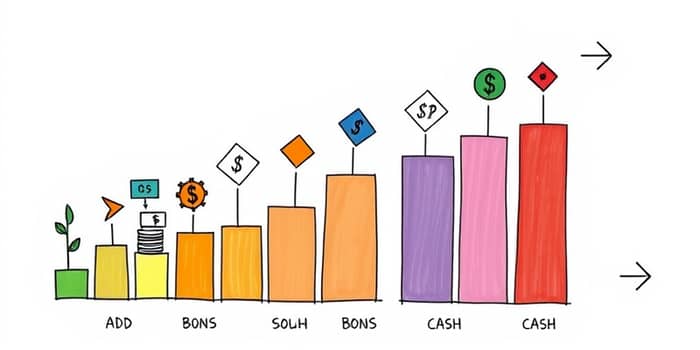
Building a portfolio without considering your time horizon can lead to mismatched expectations, unnecessary risk, and missed opportunities. By aligning your asset mix with when you’ll need the funds, you can pursue your goals with confidence and clarity.
Your investment horizon serves as a compass for every allocation decision, guiding how aggressively or conservatively you should position your portfolio over time.
Asset allocation is the process of distributing capital across different asset classes to balance growth potential and risk exposure.
At its core, asset allocation involves spreading investments across various asset classes to balance risk and reward. The three primary classes are stocks, bonds, and cash. Stocks offer growth potential but higher volatility. Bonds provide income and lower risk, while cash delivers stability with minimal returns. A thoughtfully diversified portfolio can smooth returns over market cycles.
Investment horizon refers to the length of time you plan to hold your investments before accessing the funds for a specific goal, such as retirement, buying a home, or education.
Long-term horizons allow for a more aggressive mix of equities because there is more time to recover from market downturns. For example, a twenty-something investor saving for retirement in forty years can withstand deep market dips without sacrificing long-term objectives. Conversely, if you plan to access funds in the near term for a home purchase or education, you must prioritize capital preservation and minimize volatility.
Consider a $500,000 portfolio and how asset allocation shifts as you approach your goal. In the early stages, you might choose a high allocation to growth-oriented securities. As time passes, transitioning into bonds and cash preserves capital and secures gains.
There are three main approaches to tailoring your allocation based on market conditions and personal preferences:
Several critical factors determine the ideal allocation for your portfolio. First, risk tolerance reflects both emotional comfort and financial ability to withstand losses. A higher tolerance often aligns with longer horizons and greater equity exposure. Conversely, a low tolerance suggests favoring bonds and cash to preserve capital.
Next, financial goals define your horizon and influence allocation decisions. Saving for retirement in 30 years is vastly different from funding a child’s college education in five years. Clarity around your objectives helps you select an appropriate risk-return profile.
Finally, withdrawal timing considerations vary by goal type. A lump-sum withdrawal for a home purchase demands greater safety than phased, income-driven withdrawals in retirement, where systematic distributions can tolerate periodic market volatility.
Maintaining your target mix requires regular rebalancing. As markets rise or fall, your allocations can drift above or below your intended percentages, altering your risk exposure and return potential.
Conduct reviews annually or after significant life events—marriage, job changes, inheritance—to ensure your plan remains aligned with evolving circumstances. Proactive adjustments help you lock in gains and mitigate risks before they escalate.
Failing to align your allocation with your horizon can jeopardize your financial objectives. Holding a high-equity portfolio close to needing funds exposes you to significant potential portfolio losses in market downturns. Conversely, being overly conservative early on can limit growth potential and compound returns, making it difficult to reach long-term goals.
For instance, an investor nearing retirement with 80% in stocks could face a market crash and lose major gains right before beginning withdrawals. On the other hand, a young investor allocating heavily to bonds might miss decades of equity-driven growth.
To ensure your portfolio reflects your horizon and goals, follow these steps:
Aligning your investment horizon with your asset mix is a powerful way to manage risk, capture returns, and stay on track to meet your financial goals. By understanding how time influences risk capacity, you can design a portfolio that evolves with you—from aggressive growth in your early years to conservative preservation as your goal nears.
Remember, a well-constructed portfolio is not a set-it-and-forget-it solution. It demands ongoing attention, thoughtful rebalancing, and adaptation to life’s twists and turns. By embracing a horizon-focused strategy, you position yourself to navigate market cycles confidently and pursue your most important financial milestones with clarity and purpose.
References













